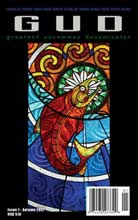
GUD (greatest uncommon denominator)
Issue 1 – Autumn 2007
USD $10
Instigator: Sue Miller
Editors: Julia Bernd, Sal Coraccio, Kaolin Fire, Sue Miller
Pages: 198
This is a dark, wicked, futuristic, funny, brilliant and up/down collection of literature. Some of it pissed me off a bit. I looked up the author of Max Velocity, and, surprised to find she was a female, realized she’d also been anthologized in an L. Ron Hubbard collection so…. Okay then. Now, it’s just I don’t really dig a scenario of no birth control and girlfriends being buried in the earth to undergo labor and having tuberic flesh-eating children. I try not to be judgmental, but a buzzer goes off in me, like, uh if there’s no point to this, isn’t it a bit dangerously misogynistic? But, then, maybe I’m not visionary enough to apprehend the true sci-fi sorcery involved. And that’s cool. It’s cool because the rest of this journal is pretty awesome. And that story was well-written and engrossing. The picture of a female torso growing branches which introduced it, made for a perfect epigraph.
I also grimaced when, at the end of Steve Dines’ “Unzipped” the Iraq War Vet loses his shit completely and smashes a mirror into the face of his well-meaning, stand-by-your-man girlfriend. I got the gritty sarcasm and post traumatic stress disordered telling of Humpty Dumpty dismantled and tortured which he read to his five year old. Again, though, it’s just the violence so exquisitely and bloodlessly drawn that kind of shakes me up these days. I appreciated the long interior monologue which the avenging vet had leading up to his final moments in a park going pervert on a kid as his woman lay in a hospital bed all scarred up. That’s the War. And that is, I’m sure, no exaggeration in some cases. It’s haunting and reflective of how military violence really does warp a soldier’s psyche.
The writing is superb. And these rather grisly tales are kind of exceptions in a sophomore strike that is even better than the journal’s debut. It’s more daring, more surreal and probably more sci-fi. It seems that in almost every case, we’re treated to a tale of life and death, fantasy and fable, reality and hyper-dream. The male violence stories can be balanced thematically against other works in which women are the mysterious and commanding witches, as in “Women of the Doll” – probably my favorite. Or the bonding that develops in an unexpectedly theatrical situation in “Aliens” by Jordan E. Rosenfeld that takes place in an Arizona organic food restaurant when one waitress is fired and the other reveals her fake sexy Russian identity to be one of many shifting personas she dons for fun and transformation. The two dance in front of mirrors in a shack filled with various outfits and wigs.
While I have a feeling that “Arrow” by Nadine Darling will be the popular fave of this collection – how do I guess this – well, my psychic voices and several friends thought so – and it is a genius hilarious conceit to have a woman pierced in the heart by an arrow she can’t remove but that also doesn’t kill her… I like “Women of the Doll.” For me, it would be a perfect short film. It is difficult to handle the subject of the supernatural with deft and earnest detail so it really seems imaginable and also incredibly out of the world, but Nisi Shawl manages to invent such a world. A woman has consecrated her life to the protection of a magical doll named Viola who comes to life on an altar and demand flowers at night and food, and lovingly calls her Auntie Josette. Auntie Josette is a pagan witch who moves from hotel to hotel with a missionary’s focus. Between her beautiful bathing concoctions and invocations, she finds men who desire her physically and then seduces them into contributing to the Doll fund. It’s a story of a woman who’s been abused and is now protected by psychic visions and witchcraft. The doll, Viola, represents a child, a dream-creature, a manifestation of female power. And I suppose, on the other side, Josette, has forfeited the usual comforts of monogamy to care for something that could become a burden, and danger, except for her pure love for the doll.
The poetry sprinkled in Issue 1 is also fine, to mention a few, Sisyphus of the Staircase, by Cami Park – a variation on the Greek myth, Tim Gager’s Your personal Ground Zero (for Franz Wright), and Catholic Girls by Kenneth Clark, among my favorites. The artwork is also special and mythical, befitting a journal with a cover sporting the stained glass Celtic Salmon of creativity.
It is a collection that has weirdness, beauty and excellence peopled by rabid robots, animated dolls, arrow-struck humans, fearless artists, crushed war veterans and wacky waitresses. It is also a cutting edge tribute to fiction as a form and to language as transcendence.
Lo Galluccio
Ibbetson St. Press



































No comments:
Post a Comment